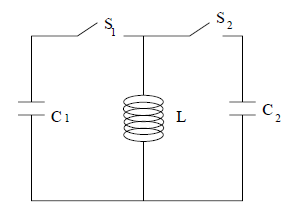
The capacitor shown in the circuit below initially holds a charge q0. The switch is closed at t = 0. Find the charge on the capacitor as a function of time, if R2/4 < L/C. What is the oscillation frequency of the circuit when R --> 0?

Solution:
Consider the circuit below, where C1 is initially charged to 75 V. Assume that C1 = 0.01 F, C2 = 0.003 F, and L = 15 H. Explain how to open and close the switches so as to discharge C1 and charge C2. Starting at t = 0 give explicit times for opening and closing each switch. What is the final voltage across C2?

Solution:
A mass m fixed to a spring of spring constant k and
immersed in a fluid provides a model for a damped harmonic oscillator. A
circuit with inductance L, capacitance C and resistance R provides an electric
analog to such an oscillator.
(a) Write out the circuit equation for the LCR circuit and Newton's second law
of motion for the damped oscillator. What assumption must be made about the
dependence of the damping of the mass on velocity for the two equations to have
the same mathematical form?
(b) How are the constants m, k, and b (damping constant) related to the circuit
constants L, C and R? To what parameters of the electric circuit are the
mechanical quantities x (displacement) and v (velocity) related?
(c) Derive and expression for the displacement and velocity in the limit of
weak damping.
(d) What voltages measured in the circuit would give values proportional to the
displacement and velocity of the mechanical oscillator?
Solution:
(b) d2Q/dt2 = -(R/L)dQ/dt - Q/(LC),
d2x/dt2 = -(b/m)dx/dt - (k/m)x.
R/L --> b/m, 1/(LC)
--> k/m.
Possible substitutions: L
--> m, R
--> b, k
--> 1/C.
Q --> x, I = dQ/dt --> v = dx/dt.
(c) Try x = x0exp(at+ d).
a2 + ba/m + k/m =
0. a = -b/2m ± ( b2/4m2
- k/m)½.
x = x0exp(-βt)
cos(ωt + d), β
= b/2m, ω2 = k/m - β2 =
ω02 - β2.
If the damping is weak then x ≈ x0exp(-βt)
cos(ω0t +
d).
(d) The voltage across the capacitor is proportional to Q --> x, The voltage across the resistor is proportional to I --> v.